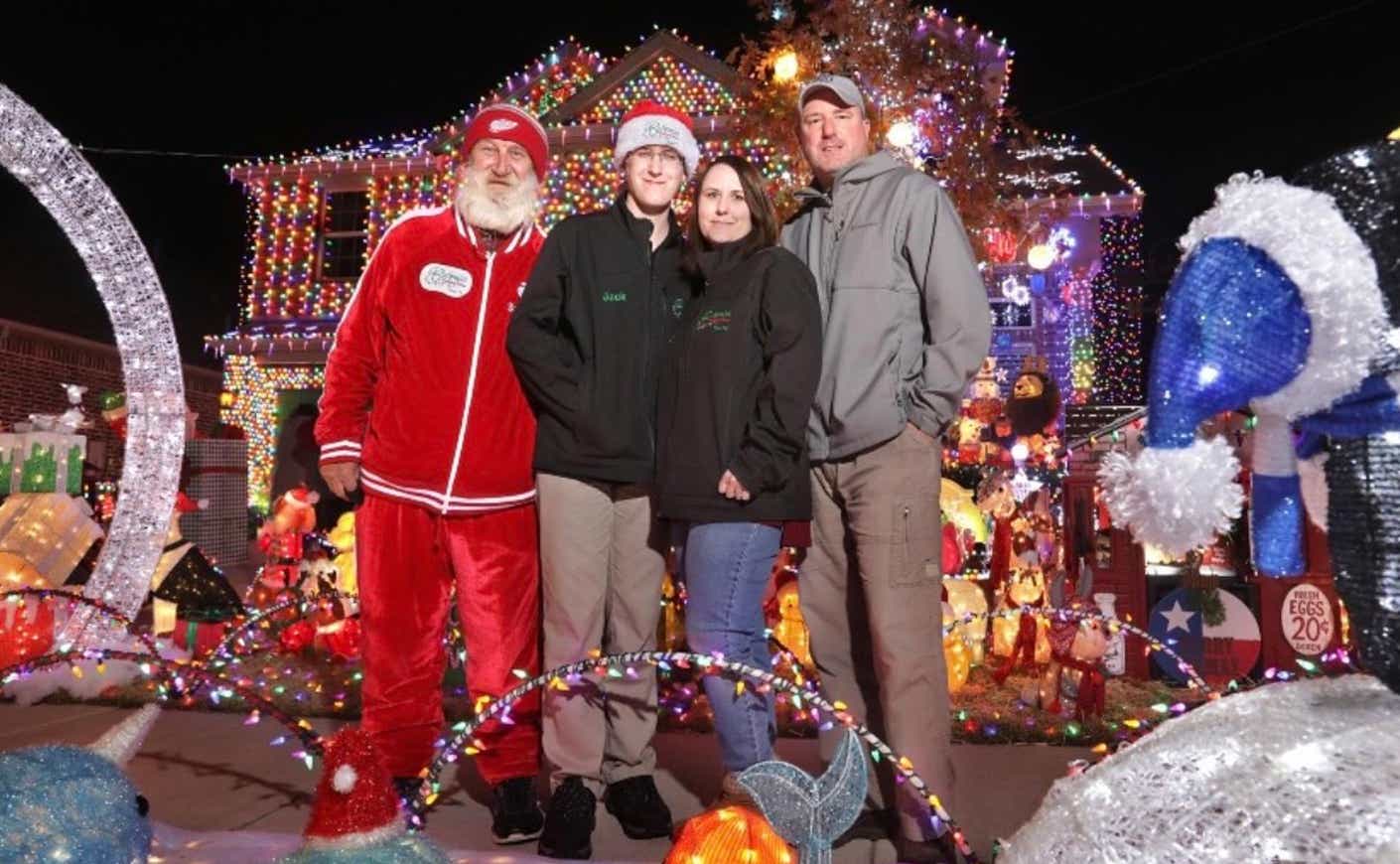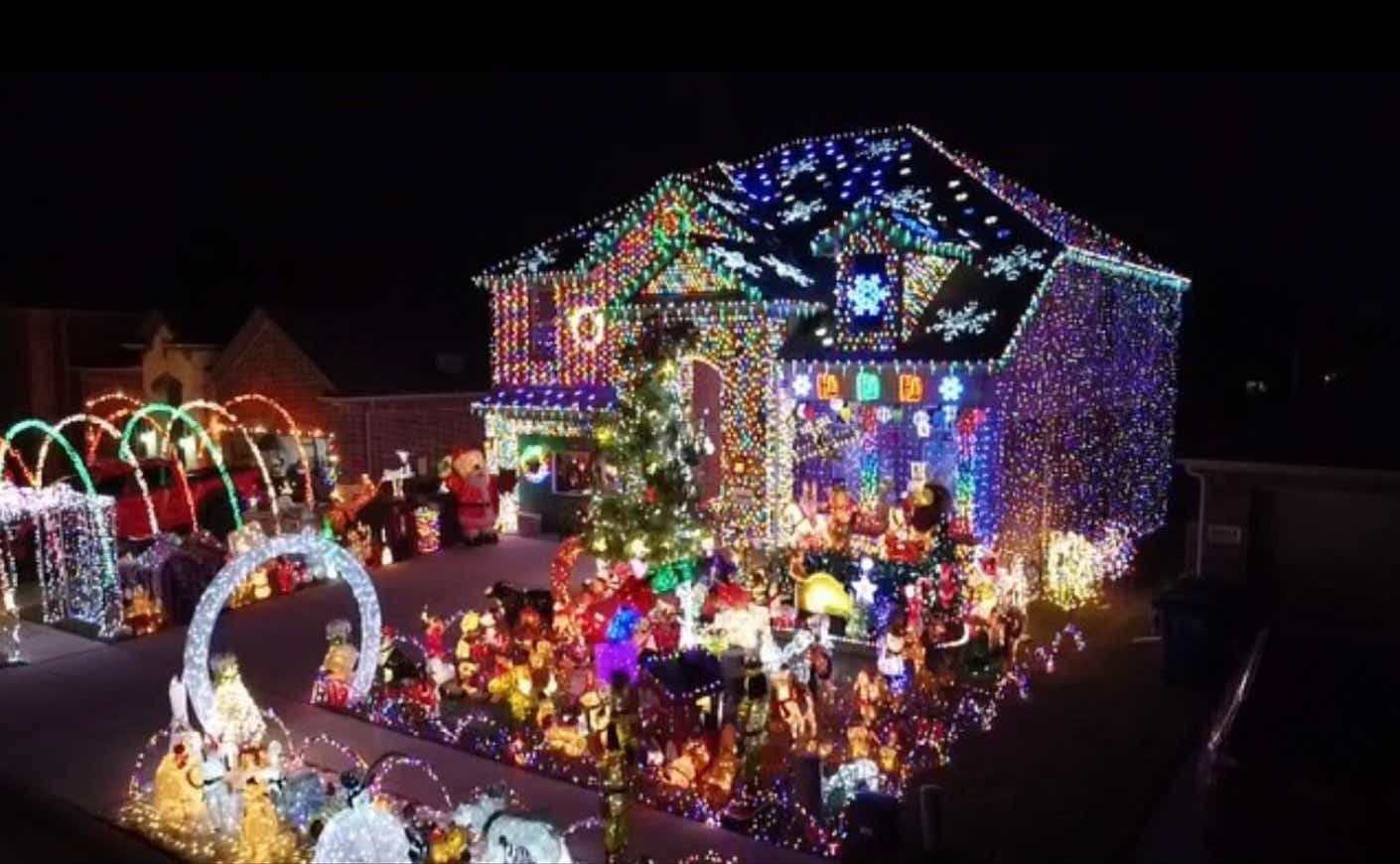What does it take to create the ultimate holiday light display? Hundreds of hours of preparation, thousands of lights, and a seemingly endless supply of Christmas cheer.
We spoke to two families who annually transform their homes into winter wonderlands and who were both featured on The Great Christmas Light Fight, a TV competition pitting extreme decorators against each other. They gave us a glimpse into how much time, energy, and money really goes into creating a spectacle.
The Burkmans: “People are afraid of us on December 26”
Decorating is truly a family affair for the Burkmans. It all started 22 years ago, when Jennifer Burkman’s father Eugene Skalskyj, who goes by “Sanpa” (a portmanteau of “Grandpa” and “Santa”), began stringing up lights for the holidays. The displays captivated Skalskyj’s grandson, Jack, who along with his older brother Alex, was diagnosed with autism.
“Christmas lights really became his passion, his fascination,” Jennifer tells us. “When he was growing up, everything involved a strand of Christmas lights. They were above his bed, in his toy room. That was our way of calming him down.”

The family started small, with a few lawn decorations and lights to spruce up their home in Utah. Things really started getting serious in 2013 when they made the move to Frisco, Texas — where snow wouldn’t disturb their decorations, the winters were mild enough for them to comfortably keep working on the display straight through December, and, of course, everything is bigger, Jennifer says.
By that point, Alex had developed a keen interest in electrical engineering and helped upgrade the display, installing extra outlets and incorporating app-controlled devices. And Skalskyj began flying in each winter from his home in Michigan to pitch in. The displays have gotten “bigger and better each year since” Jennifer says.
Prep really begins every year on Dec. 26, when stores put all their Christmas inventory on sale. “People are afraid of us on the 26th,” Jennifer says. “We are the first ones in the stores. We’ve got radios and headsets. It’s like when you see videos of Supermarket Sweep where people just take their arm and clear a shelf, that’s what we do.”
Then in June, while Frisco bakes under the Texas sun, Jennifer stays in with the A/C turned high, dreaming up LED icicles and ground covered in faux snow, she says. It’s then that the family starts constructing its big pieces, like a life-sized gingerbread house complete with a chimney that emits vanilla-scented smoke and a post office where kids can mail letters to Santa.
When things start to cool off, around the second week of October, the Burkmans begin the big project of actually attaching 10,000 lights to their home with hot glue. It takes about two weeks to glue the bulbs on just right, making it appear like the house is covered in gumdrops. (But the “hard part,” according to Skalskyj, comes later, when they have to scrape them all off the brick facade and remove the crusted glue from each bulb. “That takes literally a month,” he says.)
Things really kick into high gear after Halloween, when the “last trick-or-treater” leaves and the Burkmans begin arranging everything on their front lawn. Jennifer estimates they had more than 70,000 lights in last year’s display. About 90 percent of them are LED, which helps keep their utility bill relatively low. (Including gas, they pay about $500 every six weeks. And as for the expense of each year staging their Christmas extravaganza, Jennifer says it’s tough to pin down an exact dollar amount, but it’s probably enough to “buy another house.” )

They have about 300 lawn decorations clustered in front of their home. But last year, the centerpiece was in their garage. The Burkmans completely removed their garage door, replacing it with a wall with windows that visitors can peer through to view a twinkling miniature town blanketed in snow.
Each year, Skalskyj dons his red suit and hands out candy canes to all the children who stop by. He gave out about 20,000 of them in 2021, but he’d put the actual number of visitors at about 60,000. During the winter surge that year, most people enjoyed the Burkman’s display from inside their cars, which were backed up for six miles, according to drone footage they shot.
“It was a little wild,” Jennifer says.
Some guests leave donations, which the Burkmans have used to each year support a different family raising a child with a disability. They’re in the process of developing their own nonprofit that supports students with autism applying for college.
“It’s amazing that our Christmas lights have become so much more,” Jennifer says. “It’s really become a passion project for us.”
The Wilhelms: “Last year, we end up with 3-hour wait lines”
Andrew Wilhelm thinks he was around 4-years-old when he created his first holiday light show, by simply plugging and unplugging the strands of lights the family had hung in their living room in time to a Christmas carol. By the time he was in sixth grade, his sister Kayla was pitching in and the show had grown to 5,700 lights — at which point “mom kicked us out of the house,” Kayla says, and they started staging their shows outside.
The productions at the Wilhelms’ home in Amarillo, Texas have only become bigger, brighter, and more elaborate each year since.
The siblings begin planning nearly a year in advance. In January, Kayla, who choreographs the show, starts conceiving a theme, usually focusing on some aspect of the Christmas story. By July, the siblings are out gathering all their supplies, from run-of-the-mill Christmas lights to the “individually addressable RBG LEDs,” which can be programmed to dance and twinkle as the Wilhelms wish. (Believe it or not, Andrew says the most expensive aspect of the show isn’t the lights or even the electricity bill, but the extension cords snaked throughout the half-acre display.)
By August, they begin constructing the props, which they build by hand with their father’s help. (Conveniently, he’s a carpenter with a shop across the street from the family home.) For their 2021 show, they built eight seven-foot-tall trees and a six-foot-tall Star of Bethlehem that they covered in lights. They sliced open 200 half-gallon jugs and installed lights in each one, using them to line the family’s curved driveway.
During the summer, the siblings also begin the painstaking process of actually syncing up the 27,000 lights in the display to music. Last year, that meant manipulating each individual bulb in the faces of LED carol singers, to make it appear that they’re actually singing along. Kayla estimates she spent about 200 hours getting the timing just right.
The Wilhelms premier the performance every year on Thanksgiving night at 7 p.m. sharp. Shows run each evening until 12:20 a.m., running through Jan. 6. Twenty visitors at a time are invited to park their cars in a field across from the house, tune into the Wilhelms’ local radio station, and enjoy the 12-minute show from inside their vehicles (kind of like a drive-in movie).
The show has become a holiday tradition for many people in the area. About 18,500 cars stopped by in 2020, Andrew says.
“Everybody just loves to come and be inspired and relearn the Christmas story, or something new about Christmas,” he says.
To Andrew, this is more than a Christmas tradition; his passion for Christmas decorations could become a career. “I’m going into theater lighting management and computer information systems. The goal is doing custom lighting and sound for events,” he says.












